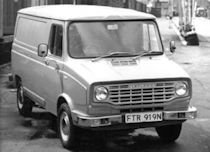Leyland Olympian
 | |
Manufacturer | Leyland Motors |
Class | Commercial vehicle |
design type | double-decker bus |
Production period | 1979 to 1993 |
engine | Diesel engines : Leyland 11.1 liters TL11 |
length | 2-axle: 9.56, 10.25 and 11 m |
The Leyland Olympian was a Leyland Motors double-decker bus produced from 1979 to 1993 .
History
The Leyland Olympian had been further developed from the Leyland Titan (B15) and replaced the production of the Bristol VRT and the Daimler / Leyland Fleetline . After the production cessation of the Leyland Atlantean in 1986, the Olympian was the only double-decker bus from Leyland. His successor was the 1992 Volvo Olympian , because Volvo had now taken over the bus division of Leyland.
The Olympian was the result of a further developed Leyland Titan (B15) . The Titan (B15) was an integral double-decker bus that was built in large numbers for London Transport (LTE). The success of the Titan (B15) at London Transport, which replaced the Fleetline there, prompted Leyland for B45 project , the result of which at the beginning of series production 1979 Leyland Olympian named. The Olympian came, as well as the Titan (B15), in many ways from the Bristol VRT . Bristol Commercial Vehicles was merged with Leyland Motors in 1965, the Olympian was initially manufactured in the former Bristol factories.
The Leyland Olympian was popular in the United Kingdom in various brands, the Eastern Coachworks, Walter Alexander Coachbuilders, Northern Counties, East Lancs, Roe, Leyland Bus (individual body) and Marshall Bus. They were ordered before and after the privatization. Operators using the bus include Boroline Maidstone (then Kentish Bus ), London Country Bus Services and Armchair Travel .The last remaining Leyland Olympians were withdrawn until December 2014, as they did not meet the requirements for disabled people.
Dublin Bus originally bought 63 in 1989, but this was increased to 175 with the completion of orders in 1992. These buses were gradually withdrawn between 2002 and 2006, with the main exception of the Leyland Olympians being used for city tours, which were withdrawn by February 2012. One of the Leyland Olympians has been returned to San Francisco and is under the branding of San Francisco Deluxe .
For the European market there was the Olympian with two axles in two different lengths of 9.56 and 10.25 meters. First, he had as the diesel engine, the Leyland TL11 with 11.1-liter displacement as a transverse power source in the rear, in response to the successful rival model MCW Metrobus with its powerful motor also optional the Gardner 6LXB or 6LXCT. Later, a 10-liter Cummins diesel engine was also available.
Especially for the export market (Asia) there was a three-axle version with lengths of 10.4 m, 11.32 m and 11.95 m. This was bought in large quantities by Kowloon Motor Bus (KMB) from Hong Kong . From 1988, the used in the export market air conditioning of the Olympian was powered by the vehicle engine, which previously accounted for additional necessary engine.
Although London Transport buys Leyland Titans, London Buses have also bought Leyland Olympians, of which 263 ECWs are built. All Leyland Olympians were withdrawn in 2005, some were converted to open-top for use in Blackpool Transport. London Transport had purchased 40 Leyland Olympians, of which it was Alexander's body in 1992, but it was withdrawn in 2005 and sold to The Original Tour , Arriva's subsidiary.
At the same time, various Hong Kong bus companies such as China Motor Bus , City Bus and Kowloon Motor Bus had purchased Leyland Olympians, of which Walter Alexander was built. Some buses were repatriated to London for use in Big Bus Company. The last Walter Alexander bus was withdrawn in December 2015. At the same time, the buses of the Big Bus Company were all sold to San Francisco , Las Vegas , Miami and Washington, DC .
China Motor Bus bought 37 Leyland Olympians from 1981 to 1993. All 35 three-axle Olympians switched to the New World First Bus, with the entire cargo of ten non-air-conditioned buses being sold to FirstGroup, which returned them to the UK in their East Counties, Glasgow, Manchester and PMT affiliates.
Following the import of some second-hand Olympians from the United Kingdom, Citybus bought 294 new Olympians. In 2003, 54 buses were repatriated to operate several buses under the Megabus brand.
Singapore Bus Services (now SBS Transit) acquired 200 Leyland Olympians in 1986-88 and 3-axle 201 Leyland Olympians in 1993-94. The 2-axle buses were withdrawn in 2003-05, and the 3-axle buses were withdrawn in 2010-13. .
After Volvo took over Leyland Bus , the production of the Olympian was continued only because of the large number of outstanding orders. After the order subdued, in 1991 the completion of the last orders of Lothian Buses, China Motor Bus, City Bus Hong Kong and SBS Transit / Singapore Buses was decided, with subsequent cessation of production of the Leyland Olympian and closure of the production site in Workington 1993th Der 1992 Available successor Volvo Olympian was a revised Leyland Olympian and was based in Irvine , Scotland produced. The last Leyland Olympian is kept by Dave Rogers (SBS9168S, later re-registered and exported as L888SBS).
The Leyland Olympian was available with different bodies of various bodywork companies .
- ECW (ECW)
- Walter Alexander Coachbuilders
- Northern Counties Motor and Engineering Company
- East Lancashire coachbuilders
- Charles H. Roe
- Leyland bus
- Marshall bus
Rating
Manuals
- Leyland Motors Ltd Previous 25 / 40 Next




